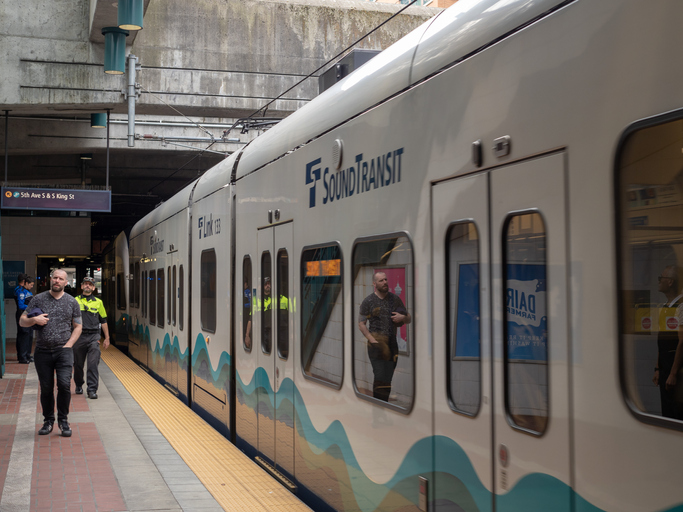Three elected officials serving on Sound Transit’s Board recently penned an editorial in The Seattle Times calling for a $15 billion increase in regressive taxes to build more light rail. Tacoma Mayor Marilyn Strickland, Everett City Councilmember Paul Roberts and Redmond Mayor John Marchione argue that building light rail is an effective way to reduce carbon emissions and improve mobility. They also compare the capacity of light rail to freeways and talk about Sound Transit’s project delivery history.
WPC found a few unsupported assertions in their editorial. You can find our first blog, “Building more light rail is not an effective way to reduce CO2 emissions,” here.
Claim: “Light-rail extensions also drive growth to urban centers where people rely less on cars, further reducing congestion and pollution.”
And;
Claim: “More mass transit would benefit riders, drivers and freight-movers alike.”
Fact: In addition to raising the property tax and sales tax rate, Sound Transit officials want to raise the unpopular Motor Vehicle Excise Tax on drivers from 0.3 percent of a vehicle’s value to 1.1 percent. That’s a new, $225 million annual tax increase on drivers residing in Sound Transit’s taxing district. The title of their column, “How to get Puget Sound traffic moving: Allow a vote on a package to fully fund light rail,” suggests that new taxes like the MVET would come back to benefit drivers by improving traffic flows.
However, environmental groups like Sightline say that transit does not reduce traffic congestion. Even Sound Transit CEO Joni Earl admits that more light rail will not provide congestion relief. She said, "We've never said we will reduce congestion."
The most recent study on expanding rail to Lynnwood shows she’s right. A formal review of the $1.4 to $2.0 billion Lynnwood Link project finds that congestion on urban freeways would remain whether or not light rail is built. The project’s Final Environmental Impact Statement found, “Freeway congestion and unreliable travel times would still occur,” and that, “congested conditions would still remain,” no matter what light rail route is chosen.
Projections show the amount people drive twenty years from now will only decrease by 0.28 percent after the $1.4 to $2.0 billion spent on building rail to Lynnwood.

When people travel, they choose light rail less than one percent of the time. Federal estimates show people in the average household make 9.5 trips per day. Within Sound Transit’s district, that equals 3.9 billion total trips every year. Sound Transit’s total light rail ridership in 2013 was just 9.7 million, or 0.24 percent of all trips people made in the taxing district. The Puget Sound Regional Council estimates that, even after light rail is vastly expanded, light rail will carry less than one percent of daily trips by 2040.
Officials say they are planning for traffic congestion to increase with or without light rail. Actually, Sound Transit officials may benefit from traffic congestion – by comparison it makes their light rail service look more attractive.
Claim: “A light-rail line can move up to 12,000 people per hour in each direction. Compare that to a highway lane that moves as few as 700 vehicles per hour in heavy congestion.”
Fact: This is an apples-to-oranges comparison. The authors compare hypothetical light rail person-capacity to actual vehicle throughput on an existing travel lane in extreme congestion. To illustrate this fallacy: When given a choice between an empty suitcase with the capacity to hold $1 million and a wallet containing $100 dollars, I’ll take the wallet.
To reach their projections, the authors assume four car rail trains, operating with full cars of 150 passengers each, running at three-minute headways (4 x 150 x (60/3) =12,000).
A lane of highway has the capacity to carry about 2,000 vehicles per hour. Using the same methodology, cars at full capacity (five people per vehicle), a freeway lane can move 10,000 people per hour. And that’s just with passenger cars. Include large vanpools and buses, and a freeway lane has a much higher capacity than a light rail line.
Claim: “Sound Transit has developed an excellent reputation for delivering major projects on time and under budget. The University Link light-rail station will open in early 2016, six to nine months ahead of schedule and $150 million under budget.”
Fact: Although Sound Transit has improved their reputation by acknowledging past troubles, this oft-repeated line is misleading. Sound Transit officials promised voters they would deliver University Link by 2006, not 2016. Sound Transit officials simply moved the goal posts and now say they’re early.
In addition, Sound Transit officials promised a 45th Street station beyond the current University Link endpoint, a project they have delayed 15 years to 2021.
Originally, Sound Transit officials promised they would to spend $2.3 billion in year of expenditure dollars for the 21 miles of rail. Yet by the time the “starter line” is complete, officials will have spent closer to $5.3 billion.
[Edited on 4/24/15 to correct tax calculation]



